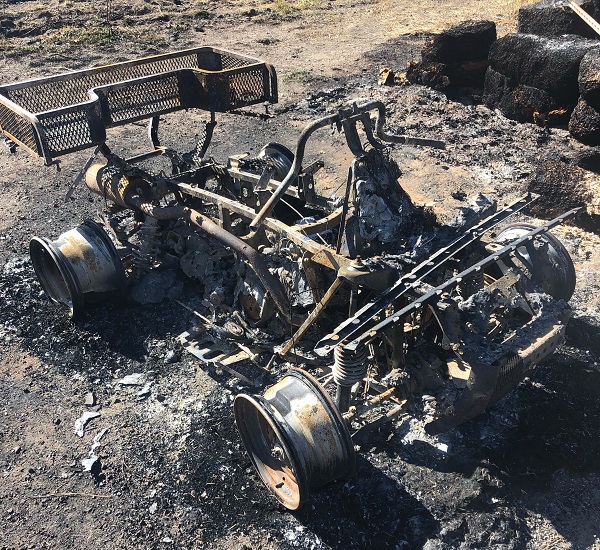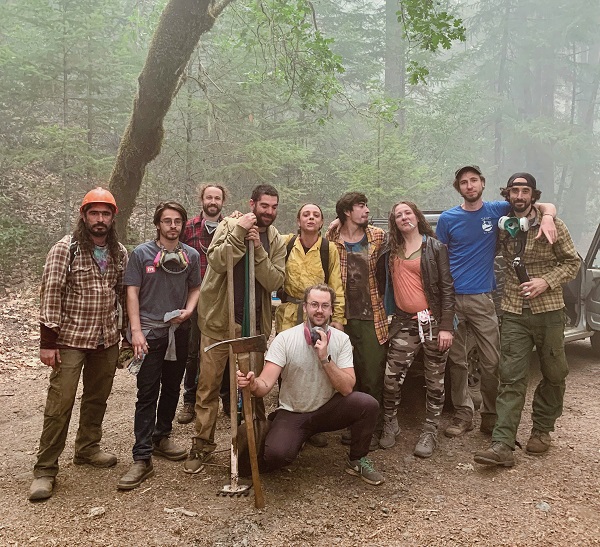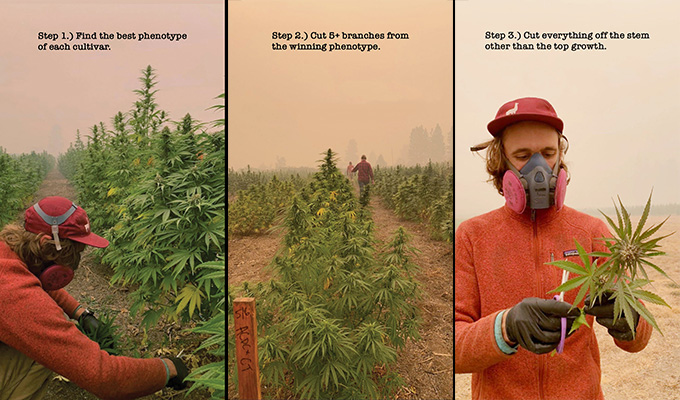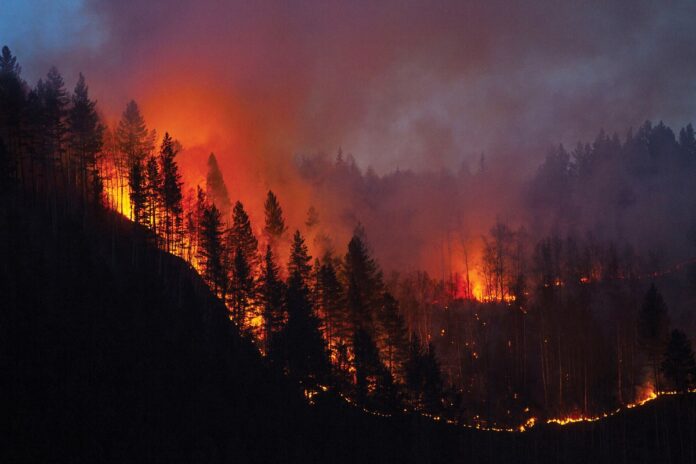Satan might have felt at home on the West Coast during 2020, where dry, hot, and windy weather created ideal conditions for flames that marauded through millions of acres for weeks on end, destroying property, livelihoods, and lives. Some blamed the blazes on lax forest management or pyromaniacs with too much free time, while others called the devastation the best evidence yet of the imminent danger from climate change.
In California alone, CAL FIRE reported 8,200 fires burned well over 4 million acres, doubling the previous annual record. Washington, Oregon, Nevada, and Colorado also went up in flames. The full impact on the cannabis industry is still being assessed as farmers tend to their damaged crops and hope the flower will pass lab tests. Meanwhile, distributors and retail outlets nervously wait for the Croptober harvest to come in and replenish retail shelves.
The pandemic has made 2020 a difficult year for everyone, but the fires have put a grim exclamation point on a year in which cannabis farmers and other operators have had to demonstrate more resilience than ever.
In the Northern Coast Range of California, the August Complex fire started in mid-August after dry lightning strikes ignited thirty-eight separate blazes in the region. With strong winds fueling flames over rugged, mountainous terrain, fires blazed a path through all three counties in the Emerald Triangle, home to some of the biggest and most well-established cannabis farms in the United States. The August Complex burned a 100-mile-long path covering nearly one million acres.
Jeff, who preferred not to use his last name, established Little Hill Cultivators in 2011 on a mountaintop in Trinity County. The outpost was one of the first licensed grows in the region. When fire began an inexorable creep toward his farm, he remained optimistic that clearing brush and trees around the land and digging fire lines would keep the damage to a minimum. As the blaze grew and spread across the region over several weeks, Jeff watched closely and prepared for the worst.
By early September, the Hopkins fire was moving northeast of Covelo, California, in the Yolla Bolly-Middle Eel Wilderness and the Shasta Trinity National Forest. When the fire summited the mountains, which top out at nearly 8,000 feet, “that kind of got everybody on alert, and the dozers started clearing fire breaks up on the ridge and in the valley,” Jeff said. “But then it just kept moving up, and they couldn’t get a lid on it. A few weeks later, it jumped the lake and came west to my valley.”
As flames moved through his 120-acre property Jeff remained on the site, braving “overpowering” winds that damaged several of Little Hill’s greenhouses. He estimated 117 acres on his property burned; the only green spots left were the tops of trees. Fortunately, Jeff expects most of the trees to recover in the spring, and the damage to his structures was minimal—a barn, a trailer, and some items in storage. “As far as clearing brush and scraping down to bare land, that really worked, and it stopped the ground fires in their tracks,” he said. “And luckily, the wind didn’t blow too much over the line. Next time I’m going to have more sprinklers to protect structures, because those worked well, but I just didn’t have enough room for everything. If I would have had one on the barn, it would have been okay.”

After the fires moved on, his farm was submerged in smoke for several weeks. The plants in the greenhouses suffered. When the power went out and his generator malfunctioned, Jeff wasn’t able to water plants properly and take other measures to protect the crops in a time of crisis.
“It turned all the hairs prematurely, and they just didn’t grow,” he said. “So, they didn’t mature properly, and I don’t know if there’s going to be a smoke taint yet. I basically abandoned two greenhouses, and I’ve probably lost at least 50 percent of the crop just due to it not maturing fully. And the weight plus the value of the quality just isn’t there.”
Countless West Coast cannabis growers share Jeff’s experience—able to save their crops but left to deal with stressed plants that didn’t reach their potential. Farmers won’t have a clear picture of the scope of damage until they weigh their harvest and perform lab testing to determine the THC and terpene levels, then compare those figures to previous years’ harvests.
By late October, the California Department of Food and Agriculture had received thirty-nine requests for license-fee deferrals and four requests for moving harvested cannabis to another licensed site as a result of the fires.
Impact on pricing and supply
Camille Roistacher, co-founder and chief executive officer at Voyage Distribution and the flower brand Wyllow, has been waiting for an influx of flower at her distribution center but hasn’t seen it yet. Flower prices across the board have been high for most of the year, she said. Of the 200 farms she works with, primarily in northern California, only a handful were impacted by the fires. However, with supplies already limited due to the upswing in sales during the COVID-19 pandemic, she anticipates a continued pinch in supply and prices that will remain high into next year. “I would say pricing and supply are where we’re going to see the biggest impact,” she said. “Then the problem with that as it continues in the supply chain, if bulk flower is still very expensive, that makes it even more expensive as it’s packaged and labeled and sold to a retailer. So, that cost is just continually passed all the way through to the consumer. Normally we see an increase in supply this time of year bringing the pricing down on the bulk side. We’ll see how we finish out the rest of the year, but I think those fires really hit us pretty hard.”
Etienne Fontan, vice president and co-owner of Berkeley Patients Group (BPG) and a founding board member at the National Cannabis Industry Association, said BPG sources about 50 percent of its flower from outdoor growers and does not buy flower tainted by smoke. “Prior to Prop[osition] 64 we had a large network of growers, but the network has changed and now we’re reliant on distributors,” he said. “And even some distributors won’t know until the products pass testing, so we’re still kind of in a gray area of just not knowing” how the market will look.
A similar scenario is playing out in Oregon, where Jesse Bontecou, deputy director at the Oregon Retailers of Cannabis Association, said the state was beginning to experience a shortfall in flower supply before the fires. When the pandemic started, he said, Oregon experienced new records in sales month after month. “We’re hearing from retailers and wholesalers that they were having a hard time finding flower, and the prices have been increasing significantly since 2018,” he explained. “So, availability was already a problem and I think there is some concern, but we don’t know what the effect is going to be yet. I think we should expect to see a small increase in the wholesale cost of flower, at least until the fall harvest comes in. We’re all waiting to see to what degree this affects the marketplace.”
California companies large and small have struggled since Prop. 64—officially the Adult Use of Marijuana Act—passed, bringing with it with high taxes, stiff competition, and plenty of red tape. Flaming farms certainly haven’t improved the situation. The dilemma for growers with smoke-damaged crops is whether to send them to an extraction facility or spend the money to have them tested, hoping they will pass muster. Since the value of flower is much higher than trim—the primary source material for extraction—many farmers will roll the dice and try to take their flower to market.

Not all smoke is created equal. Burning brush leaves everything coated with ash that doesn’t poison plants, but when buildings and other structures burn the smoke and ash likely include toxic byproducts produced by the chemicals used to treat wood and other construction materials. The fire retardant dropped from planes to help control the spread of flames can destroy or seriously damage flowers because it, too, contains dangerous chemicals.
Jeff Gray, founder and chief executive officer at SC Laboratories in Santa Cruz, California, said state regulatory agencies require testing labs to test for a specific roster of substances (pesticides, cannabinoids, mycotoxins, etc.). Contaminants not on the list may go undetected, meaning contaminated flower could end up in the retail market legally. “Some people were thinking there could be toxicity in the smoke because you’re looking at houses that are burning, so we’re looking at chemicals in the air that could possibly be dangerous,” he said. “There’s a lot of different factors, but in the past, we didn’t see a lot of people fail tests against the regulated panel we run. So, I didn’t see a spike in contaminants being present in flowers that were grown in the areas affected by fires.”
Gray also noted SC Laboratories, which operates in both California and Oregon, is in the process of developing a smoke test modeled after those used in the wine industry, which, due to its longevity, has much more experience with fire damage. “Anytime you apply something from one industry to another, there’s going to be some shortcomings,” he said. “When we start running these labs, I’ll be able to provide insight into the presence of chemicals that aren’t normally tested for. It’s possible—but like I said, we haven’t seen it and we haven’t seen a ton of evidence to support that.”
Fontan said BPG was one of the first dispensaries in the U.S. to start testing flower, primarily to measure THC levels. “There’s going to be carbon fallout and different readouts that are going to show anomalies in tests from years past,” he said of testing smoke-damaged flower. “The damage is there and it cannot be washed off like [it can be from] grapes or fruits because of the sticky nature of the exterior of the [cannabis] plant. So, unfortunately, whatever falls upon [cannabis plants] will go through and be part of the testing reality. And some growers are in for a rude awakening, but that is the reality of farming.”
Faced with an early, unplanned harvest, some farmers have had to dry and cure their crops in ad hoc storage spaces, raising concerns about microbial contamination and other damage that could result in failed lab tests. Even in scenarios where smoke-tainted flowers are able to pass testing, knowledge the plants were harvested in smoke-saturated areas makes selling into the retail market much more difficult.
“I would outright reject a [smoke-damaged] product that made it through our system because I know contaminants are there,” Fontan said. “We used to joke about how this year’s fire crop would be sold as ‘Hickory Kush’ on the East Coast, because we are educated cannabis people here in California and won’t accept that.”
“The smoke smell makes it very challenging to sell,” said Roistacher. “If we can smell it, and then if it doesn’t pass the [certified lab analysis], we just can’t do anything with it. So, it’s going to be very, very challenging for those farmers.”
Seeking help
In Oregon, just up the road from Humboldt County and near the town of Takilma, East Fork Cultivars grows nearly ten acres of hemp and adult-use cannabis. When fires crept to within a mile of the farm, co-founder and President Nathan Howard and his team used hoses to soak the property and tractors to dig fire lines along the border. After the county issued a mandatory evacuation order, the crew returned to the farm by day to move equipment, genetics, and other valuable assets to safety.
“Even though we had a mandatory evacuation, we kept going to the farm, despite the fact we could see fire half a mile from us burning away,” Howard said. “We could hear the fire roaring, and at times the wind would shift and it would come toward our farm. Smoke and ash and smokey taint is much less of a concern to us at this point than just the actual impact on harvest operations, which will unfold as the rains start to come. The story is still playing out because there are people, including us, who still have tens of thousands of pounds of cannabis in the ground that need to be hand-harvested throughout southwest Oregon and up and down the West Coast.”

This is the third season during which East Fork has suffered from smoky conditions. The farm has escaped serious damage each time and has had no major issues with smoke damage or tainted crops. “How much yield are we actually losing from those smokey days and the reduced UV? We don’t really know. One of these heavier smoking years in 2018 was a total banner year. But there’s that question about how much we could have grown and how much more chemical production we would have had with unmitigated sun for the entire season.”
Nearly 20 percent of Oregon’s licensed cannabis companies are located in evacuated areas. A September survey by the Oregon Liquor Control Commission, the state agency that licenses cannabis businesses, found:
- Of the twenty licensees in “wildfire burn zones,” twelve were a total loss: nine retailers, two labs, and one producer.
- Of those in evacuation zones, thirty-four were under a Level 3 alert (“go now/leave immediately”), five were under Level 2 (expect an evacuation order soon), and five were under Level 1 (be ready to leave if necessary).
- Of those licensees who experienced crop damage, seven said they had “complete” damage, twelve had “partial” damage, and fifteen had “unknown” damage. Thirteen respondents reported no damage.
“Obviously there were fires back in 2017 that caused similar disruptions in relation to people being evacuated and smoke and things like that,” Bontecou said, “but as far as I remember, there was no direct fire damage. This year there were whole towns that were essentially destroyed, and we have not seen that level of damage before. It is tragic, and for people that don’t have a lot of resources available, such as insurance or federal aid in case of emergencies, it’s really destructive.”
When natural disasters strike, state and federal aid is often available. Cannabis remains a federally illegal substance, so businesses in the sector don’t qualify for federal disaster aid. Likewise, insurance companies are reluctant to write policies for cannabis farms; only a small percentage of farmers carry any type of insurance against crop damage.
U.S. Senators Ron Wyden and Jeff Merkley and U.S. Representatives Earl Blumenauer and Peter DeFazio—all Oregon Democrats—in September introduced legislation that would ensure state-legal cannabis businesses can qualify for disaster recovery programs like any other business. “Cannabis businesses in Oregon hurt by the blazing wildfires or any other disaster shouldn’t be shut out from federal relief simply because the federal government is stuck in yesteryear,” Wyden said. “These legal small businesses employ thousands of workers and support our struggling economy. If they need federal support, they should get it. Full stop.”
Although the federal government likely won’t provide aid, industry members in California and Oregon are seeking ways to work with state officials to find assistance for legal businesses impacted by fires and other disasters. “We have internally started a conversation about going to the state and trying to set aside some of the cannabis taxes the state is currently collecting but not spending on the industry and creating an emergency fund,” said Bontecou. “People are beginning to think about how we need to plan for this, because it does seem like it is going to be a reality that we’re dealing with in the future and a growing threat that demands and deserves attention, especially for an industry that’s so large in Oregon. I mean, currently we are on track to surpass a billion dollars in sales this year, which is no small feat.”
While wildfires will continue to be a serious issue for West Coast farmers, there is a silver lining, of sorts: After fires have consumed all the dead leaves and other debris on a forest floor, out-of-control blazes are much less likely to occur in that area again, at least for a while. Fires also rejuvenate whatever plant life remains and spur new growth by returning nutrients to the soil.
Little Hill and East Fork hope this year’s blazes will reduce the chance a major fire will flare in their vicinity in the foreseeable future. “We have just an immense amount, about 150,000 or more acres, of [wildfire] fuel we don’t have to worry about now,” said Howard. “We’re sitting pretty. I mean, the skies are blue with a few clouds. We’ve been harvesting under pretty much ideal conditions all day. So, we are in stark contrast to having a 1,000-plus [Air Quality Index] for consecutive weeks with the fires half a mile away from us just a few weeks ago.” (An AQI value of 300 is unhealthy; anything over 500 is hazardous.)
“It could have been a lot worse,” Little Hill Cultivators’ Jeff said. “I would trade the crops for my infrastructure any day, and I lost a lot of crop, but all in all I’m definitely in a good position to rebuild and get back at it next season.”









